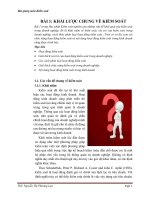Individual essay nguyễn huỳnh phương lan AEn T321WSB 6 21000384 1
Bạn đang xem bản rút gọn của tài liệu. Xem và tải ngay bản đầy đủ của tài liệu tại đây (142.74 KB, 14 trang )
SCHOOL OF Western Sydney University
ASSIGNMENT COVER SHEET
STUDENT DETAILS
Student
Nguyễn Huỳnh Phương Lan
name:
Student ID
number:
UNIT AND TUTORIAL DETAILS
Unit
AEn unit
name:
Tutorial group: AEn unit
Lecturer or Tutor
Mr. Gabriel C. Ryan
name:
21000384
Unit
number:
Tutorial day and
time:
T321WSB-6
Mon-Tue-Thu
(8:00 – 11:15)
ASSIGNMENT DETAILS
Title:
Individual Essay Assignment
Length
Due
:
1398 words
date:
Home campus (where you are
enrolled):
02/01/2022
Date
submitted:
02/02/2022
Viet Nam
DECLARATION
I hold a copy of this assignment if the original is lost or damaged.
I hereby certify that no part of this assignment or product has been copied from any other
student’s work or from any other source except where due acknowledgement is made in the
assignment.
I hereby certify that no part of this assignment or product has been submitted by me in
another (previous or current) assessment, except where appropriately referenced, and
with prior permission from the Lecturer / Tutor / Unit Coordinator for this unit.
No part of the assignment/product has been written/produced for me by any other
person except where collaboration has been authorised by the Lecturer / Tutor /Unit
Coordinator concerned.
Nguyễn Huỳnh Phương Lan | 1
I am aware that this work will be reproduced and submitted to plagiarism detection software
programs for the purpose of detecting possible plagiarism (which may retain a copy on
its database for future plagiarism checking).
Student’s
signature:
Lan
Note: An examiner or lecturer / tutor has the right to not mark this assignment if the above
declaration has not been signed.
Nguyễn Huỳnh Phương Lan | 2
INDIVIDUAL ESSAY
THE EVOLUTION OF E-COMMERCE:
BEFORE AND AFTER COVID-19
by Nguyễn Huỳnh Phương Lan
AEn-T321WSB-6
Nguyễn Huỳnh Phương Lan | 3
Mr. Gabriel C. Ryan
Western Sydney University
Hồ Chí Minh City
02/01/2022
Nguyễn Huỳnh Phương Lan | 4
Exposing to alternative technological advancements in transmission, operation, and
maintenance, a broad range of possibilities were precisely accounted for with the growth of the
Internet beginning in the 1990s (Santos et al, 2017). Acknowledging the potential, some
businesses worldwide began to utilize online network platforms to communicate with their
customers - initially, to disseminate products’ details, then to receive orders, and finally to
distribute merchandises and services - up to the open arrival of e-commerce, which would cover
even receipt and reverse logistics. Manzoor (2010, p.2) had once stated that e-commerce is the
term for applying electronic devices and technological improvements to supervise merchandise.
Henceforth, electronic commerce has widely spread all over the world and has become an
indispensable utility. Thereby, following the worldwide epidemic of Covid-19, which forced the
majority of the world's population into lockdowns and quarantines, e-commerce (EC) was
claimed to have peaked with numerous advantages. This present article aims to outline a brief
history of the beginning and evolution of electronic commerce, also highlight the significance
elevation post-Covid-19 and the reasons for this evaluation.
To begin with, several scholars and stakeholders in the area have investigated and
monitored the evolution of e-commerce. Given the advances in information technology,
Nguyễn Huỳnh Phương Lan | 5
particularly with the emergence of the Internet, a wide variety of possibilities were perceived
beginning in the 1990s, with a noted emphasis on communication.
E-commerce was believed to have its first phase in the 1970s when private
correspondence networks were exclusively operated by major enterprises to conduct financial
transactions and document exchanges electronically via electronic fund transfer systems
(Galinari et al., 2015). (Albertin, 2012) believed that the evolution of EC could possibly be
classified into four periods. Organizations employed the Internet's features for information
dissemination about their products and services in Phase One, which was the catalyst for the
creation of EC. The article also claimed that Phase Two consisted of accepting orders and giving
information and instructions on how to use their products and services. During this age, logistics
began to have an influence on businesses. According to the same author, phase three of the
evolution was the use of information technology (IT) to distribute products and services. Some
products, including music and software, began to be sold digitally during this time. Finally, the
EC consolation phase begins with the interaction between the seller and the client, which is no
longer limited to data transmission or product and service distribution. Given the capabilities of
EC, such engagement enabled the ordinary internet user to become a prospective customer with
the advancement of IT and widespread usage of the Internet. That instrument ushered in a
Nguyễn Huỳnh Phương Lan | 6
genuine revolution in how products, services, and information are sold, providing more
convenience and a wider range of offers and possibilities for consumers, as well as sellers who
participate in the market.
It is natural for businesses to experience structural changes, and globalization has
contributed to this strong tendency. Globalization has resulted in the rise of more contemporary
styles of firm management as a result of increased competitiveness, the need to provide
innovation, and rising customer expectations. According to (Santos et al, 2017), in recent years,
advances in broadband Internet connectivity have proven critical for the growth of EC. Since
2012, when 3G and 4G technologies were introduced in Brazil, mobile devices such as
smartphones and tablet PCs have had access to high-speed Internet. Such technology makes it
easier for customers to compare prices in different areas. Some customers utilize that resource
even while they are in physical locations, where they may interact with the goods and pick the
purchasing channel of sales that best suits their needs.
The evolution of EC corresponds to the stages of digital environment evolution – an
evolution that must be understood and ensured via the issues that must be considered when
Nguyễn Huỳnh Phương Lan | 7
utilizing the EC – with the goal of ensuring the usage of its contributions. As a result, the
progress of EC influences the development of information technology. The implementation of
EC phases in business operations is another dimension that completes the analysis of EC phases
(Albertin, 2000). Electronic commerce, far from being a fad, became a reality in this way.
Modern businesses strive to adapt their structures to meet the needs of new customers, who are
more concerned with comfort. Therefore, using new technology to achieve this goal is a typical
method.
At present, coronavirus has drastically transformed global trends. A rapid change has
occurred in every business. It has altered humans’ behaviours, the nature of trading, business and
even the way of life. It fostered fear among people, causing them to avoid interacting with others
and leading to the decline in the global economy. Regardless, the fact that it has provided a
significant boost to the growth of the electric industry, and e-commerce in specific, is beyond
doubt. According to (Bhatti et al, 2020), Walmart grocery e-commerce had increased by 74% in
2020. Likewise, although e-commerce in Pakistan had had a poor start in the 2000s with only 3%
of the whole population purchasing their supplies online, it is reported that the number had
enlarged by 10% in the daily record and 15% rise in internet users.
Nguyễn Huỳnh Phương Lan | 8
On the contrary, isolation tactics and recommendations, according to (Pantelimon, 2020),
have severely reduced client spending in physical businesses, e.g jewelry, retail healthcare,
luxury goods, and tourism. (Salem&Nor, 2020) discovered that there was a plunge in restaurants,
groceries and brick and mortar retailers sales a few weeks after the Covid-19 outbreak in the U.S.
As a result, customers shifted their purchases from physical establishments to e-commerce. A
survey carried out by (Pantelimon, 2020) on 10,000 people worldwide reported that more than
half of respondents in Vietnam, China, and India do online purchases more frequently than
before, followed by Italy with one-third of respondents. However, the report also found that a
high level of e-commerce already existing in Germany, France, Canada, Australia, the U.K and
Japan might be the cause for less than 20% of respondents expecting changes in their online
buying habits.
Moreover, online-based meeting rooms and apps had also gained popularity and highlygrown profit. In 2020, as companies and organizations signed up for the video conferencing app
such as Zoom, an online meeting platform, in order to accomplish remote-working during the
pandemic, revenue surged more than 350% in the second quarter, and profits rocketed by nearly
10 times as much (He, 2020). Furthermore, the California-based video communication service
Nguyễn Huỳnh Phương Lan | 9
provider posted a net profit of $185.7 million for the quarter ended July 31 st, 2020, up about
3,300% compared to the previous year. The quarter's revenue was $663.5 million, up 355%.
In addition to the trading and services businesses affected are sporting events that are
now being played behind closed doors; out of view of the teeming spectators (Salem&Nor,
2020). Notwithstanding, electric commerce has seen another advantage since the Saudi Arabian
spectators have been restricted to watching these games on televisions and live streaming via
online networks. The same case was also applied to concerts, shows, events, and festivals.
However, their profit somehow was on another level. According to (Dong, 2020), K-pop idols’
virtual concerts have become a multi-million dollar occupation. BTS, a K-pop boy band, had
earned 18 million U.S dollars from 750,000 paid viewers worldwide without any transportation
and physical stadium stage fees charged.
Due to the social-distancing limitations that prompted the production of sufficient
equipment to suit living and leisure demands, it is clear that e-commerce has gained enormously
as a natural outcome of the Covid-19 situation. As a result, future projections on the severe
Nguyễn Huỳnh Phương Lan | 10
expansion of EC, including the widespread use of remote-working a.k.a. online-based enterprises
communicating networks, and the dominance of A.I., are indisputable.
In conclusion, this essay provides a brief summary of the beginning and growth of
electronic commerce dating back to the 19th century. Presently, it also highlights the post-Covid19’s elevation relevance and the possible basis behind this assessment. Indeed, alongside a skyrocket technological device and feasibilities’ extension, the development of e-commerce is
inevitable, with the Covid-19 situation delivering an accelerating boost. As can be seen, current
social-distancing restrictions have been seen as the main cause for this elaboration. Thereupon,
the increase in the competitive nature of e-commerce will continue to push traditional stores
towards digital adjustments.
Nguyễn Huỳnh Phương Lan | 11
References list
Albertin, A. L. (2000). O comércio eletrônico evolui e consolida-se no mercado brasileiro.
Revista de Administraỗóo de Empresas, 40(4), 94102.
Albertin, A. L. (2012). Comộrcio eletrụnico: da evoluỗóo para as novas oportunidades.
GVexecutivo, 11(2), 66–70.
Bhatti, A., Akram, H., Basit, H. M., Khan, A. U., Mahwish, S., Mahwish, N., & Bilal, M.
(2020). E-commerce trends during COVID-19 Pandemic. International Journal of Future
Generation Communication and Networking.
/>
Dong, H. S. (n.d.). BTS and SuperM Online Concerts Keep K-Pop Industry Ticking over, but
Smaller Acts Are Struggling, South China Morning Post.
Nguyễn Huỳnh Phương Lan | 12
/>module=perpetual_scroll_0&pgtype=article&campaign=3102334
He, L. (2020). BTS and SuperM online concerts keep K-pop industry ticking over, but smaller
acts are struggling. Zoom Profit Skyrockets 3,300% on Remote Work Trend, CNN
Business. />
Galinari, R., Cervieri Júnior, O., Júnior, T., Rodrigues, J., Rawet, E. L., & others. (2015).
Comércio eletrơnico, tecnologias móveis e mídias sociais no Brasil. BNDES Setorial, Rio
de Janeiro, (41). Retrieved from />
Manzoor, A (2010). E-commerce: An introduction. Lambert Academic Publishing.
Pantelimon, F.-V., Georgescu, T. M., & Posedaru, B.-S. (2020). The impact of mobile ecommerce on GDP: A comparative analysis between Romania and Germany and how
Nguyễn Huỳnh Phương Lan | 13
covid-19 influences the e-commerce activity worldwide. Informatica Economica,
24(2/2020), 27–41. />
Salem, M. A., Nor, K. (2020). The Effect Of COVID-19 On Consumer Behaviour In Saudi
Arabia: Switching From Brick And Mortar Stores To E-Commerce. International Journal
of Scientific & Technology Research, 9(7).
/>VID19_On_Consumer_Behaviour_In_Saudi_Arabia_Switching_From_Brick_And_Mortar_S
tores_To_E-Commerce
Santos, V. F., Sabino, L. R., Morais, G. M., & Goncalves, C. A. (2017). E-commerce: A short
history follow-up on possible trends. International Journal of Business Administration,
8(7), 130. />
Nguyễn Huỳnh Phương Lan | 14









